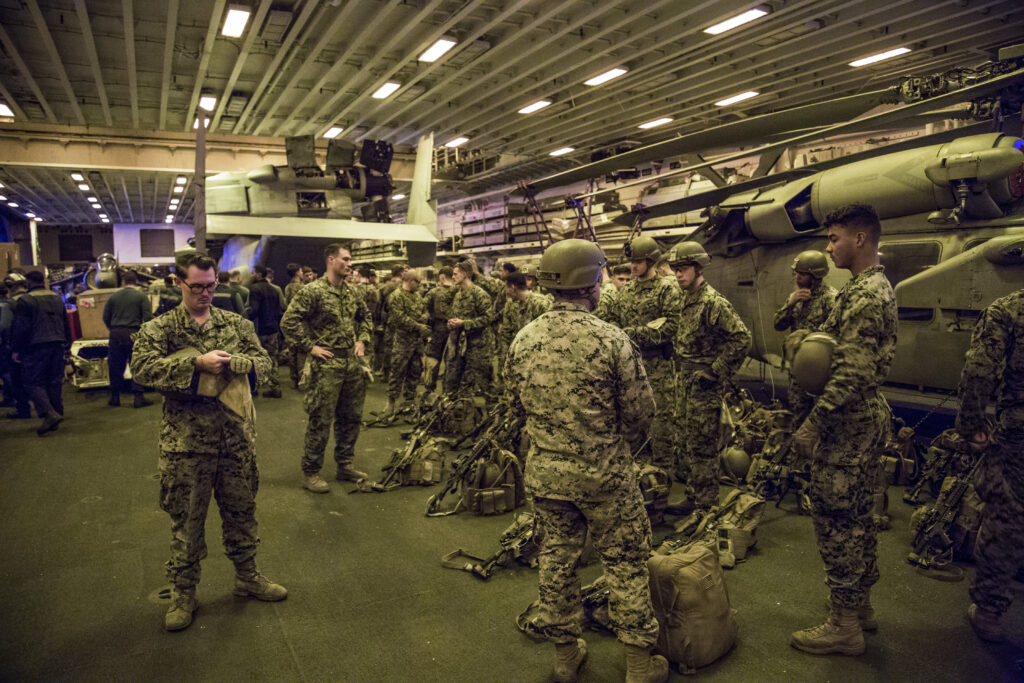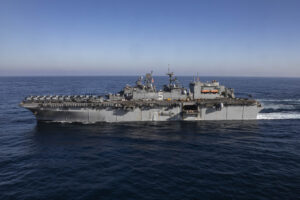By PAUL MCLEARY
 WASHINGTON: In a remarkable few hours, Iraq’s parliament voted Sunday to remove US forces from the country over the killing of Iran’s Qassem Soleimani in Baghdad two days earlier. The US also suspended its efforts in Iraq to hunt ISIS fighters and to train Iraqi forces.
WASHINGTON: In a remarkable few hours, Iraq’s parliament voted Sunday to remove US forces from the country over the killing of Iran’s Qassem Soleimani in Baghdad two days earlier. The US also suspended its efforts in Iraq to hunt ISIS fighters and to train Iraqi forces.
That drama unfolded as thousands of US paratroopers, Marines, and US warships flowed into the region.
Just hours before the Iraqi vote, during which lawmakers chanted anti-American and pro-Iranian slogans, the American command in Baghdad announced a halt to all operations in the country. “We are now fully committed to protecting the Iraqi bases that host Coalition troops,” the command said after several rocket attacks struck US positions Saturday. “This has limited our capacity to conduct training with partners and to support their operations against Daesh and we have therefore paused these activities, subject to continuous review.” The Iraqi vote to expel was a non-binding resolution so nothing has to happen right away and it may be an indication that leaders are signalling to the Iraqi people that they care but need American and allied forces for other reasons.
While events play out in Baghdad, 3,000 US paratroopers are moving into Kuwait, and a potent force of roughly 2,500 Marines is steaming through the Mediterranean, capable of arriving in the Middle East within days. We don’t know their position, unsurprisingly.
The Marines making up the 26th Marine Expeditionary Unit are trained to move from their ships via Osprey tiltrotors to provide quick reaction forces for embassy protection, evacuating civilians by air and sea, and to provide a deadly punch with Harrier jets, Super Cobra attack helicopters, and heavily-armed infantry troops and combat engineers. The MEU is part of the USS Bataan Amphibious Ready Group including the amphibious transport dock ship USS New York, and dock landing ship USS Oak Hill.
Col. Trevor Hall, commanding officer of the 26th MEU, said in an official statement that the unit “possess the unique ability to move seamlessly between operations at sea, ashore, and in the air. We provide commanders with a forward-deployed, flexible, and responsive sea-based Marine Air-Ground Task Force.”
Most analysts are skeptical that Iran would respond with a frontal assault on US military targets to the killing of Soleimani, predicting Tehran will resort to smaller, asymmetric attacks on softer targets such as US embassies, economic interests and allies. The Marines will take some of the weight off the 173rd Airborne Brigade Combat Team out of Vicenza, Italy, who have reportedly been put on alert to protect the US Embassy in Beirut if needed.
Former CENTCOM commander Joseph Votel, who was on the front lines for various confrontations with Iranian forces, said “a very high level of vigilance and readiness to an Iranian response,” is critical across the board for the Trump administration. “I think that right now it is really important to be clear and consistent in our communication on why we acted; highlight our enduring interests in this area; clarify our strategy going forward; and address our critical regional relationships,” he told me in an email.
USS Bataan (LHD5).
 The arrival of the 2,500 Marines and the 3,000 paratroopers will add to the significant American troop buildup in the Middle East over the past several months, bringing the total to about 20,000 since the summer. The Trump Administration has said the buildup, which includes new air wings and missile defenses sent to Saudi Arabia in the wake of Iranian drone and cruise missile attack on a major oil facility there in September, are for self-defense purposes.
The arrival of the 2,500 Marines and the 3,000 paratroopers will add to the significant American troop buildup in the Middle East over the past several months, bringing the total to about 20,000 since the summer. The Trump Administration has said the buildup, which includes new air wings and missile defenses sent to Saudi Arabia in the wake of Iranian drone and cruise missile attack on a major oil facility there in September, are for self-defense purposes.
President Donald Trump appeared in no mood to cool things down, threatening on Saturday night to hit 52 Iranian sites “very hard” if Iran attacks Americans or US assets. The number of sites represented the 52 Americans held hostage in Iran in 1979 after militants seized at the US Embassy there. The sites are “at a very high level & important to Iran & the Iranian culture, and those targets, and Iran itself, WILL BE HIT VERY FAST AND VERY HARD,” he tweeted.
Marines have hit the beaches to evacuate civilians before. In 2006, the 24th MEU landed on a Beirut beach to evacuate Americans to the amphibious assault ship USS Nashville after heavy fighting erupted between Israel and Hezbollah fighters.
A former destroyer captain, Bryan McGrath, head of the Ferrybridge Group, told me the ships and Marines bring “immediate proximate power that can be projected ashore in the event of additional staged embassy protests. We have a number of embassies and consulates in the region, and with 2,500 Marines afloat within a MV-22 ride, that provides significant reinforcement.”
Spokesman for the 6th Fleet, Lt. Cmdr. Matthew Comer, said in a statement the Bataan and MEU are “conducting routine operations, demonstrating the inherent flexibility of our naval forces.”
The Bataan ARG will joining the USS Harry S. Truman Carrier Strike Group currently in the North Arabian Sea, and the UK’s HMS Montrose and HMS Defender — a frigate and destroyer respectively — which have been dispatched to accompany British-flagged ships through the Strait of Hormuz. Brig. Gen. Gholamali Abuhamzeh, commander of the Islamic Revolutionary Guard Corps (IRGC) in the southern province of Kerman, said Friday night that his country had identified 32 targets including ships, the Tasnim News Agency said. That is what apparently prompted Trump to offer the 52 Iranian targets America has painted on maps.
No comments:
Post a Comment